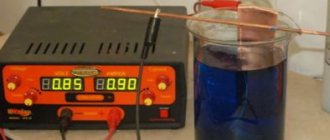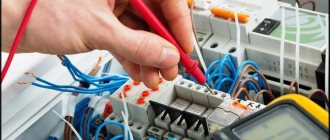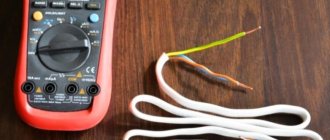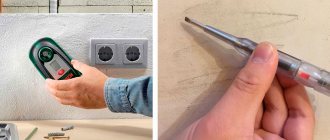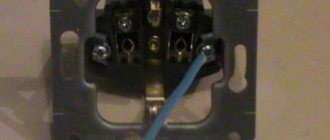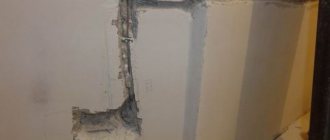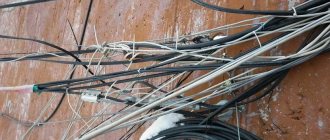Hidden wiring has a lot of advantages, but there is also one important disadvantage - in the event of a faulty electrical wiring, redevelopment and lack of an electrification plan, it is extremely difficult to find the desired area under the interior decoration. Let's figure out how to find wiring in the wall to eliminate the possibility of damage. There are many effective ways to determine electrical wiring in a room, and to choose the appropriate option, let’s take a closer look at them.
Detection of hidden wiring using a special device Source googleusercontent.com
Advantages of hidden installation and why you need to know where the wires go
When planning a home renovation or redevelopment, the question often arises of how to find hidden wiring in the wall. External wiring in homes was made before, but now it is rarely used, mainly as an element of a design solution, when the wires are simply attached to the wall.
This is what modern external wiring looks like Source yandex.net
The method of external wiring was abandoned and hidden installation was preferred because of its safety and aesthetics, when the cables are laid in grooves and then covered with putty. During repair work, you have to drill into the walls and in order not to damage the electrical wiring, you need to know its location.
Information about electrification is necessary in the following situations:
- redevelopment of the entire electrical wiring diagram;
- partial replacement of electrics;
- redevelopment of the home itself;
- emergency situations;
- design change.
If the task is to completely replace the electrical wiring, then you can ignore the location of the old wires. However, you still need to make sure that the new and old wiring do not intersect.
Alternative methods
Visual search.
If these devices are not available, then alternative methods can be used. And the first of them is visual.
In the process of sealing grooves with cables, it is not always possible to do everything very smoothly.
Therefore, it is often possible to detect the location of the wiring along a small protrusion, but for this you need to carefully examine the room, and the wallpaper will have to be removed - the wall must be “bare”.
Radio.
An ordinary radio receiver, which does not need to be modified, can also help in the search. It is enough to set the frequency on it to 100 kHz. And then we take the receiver and go searching.
To detect, we move the antenna along the wall. The cable detection signal will be an increase in noise from the speaker.
The accuracy, of course, is not high, but it is quite possible to determine the channel with the wiring.
You can also use an old tape recorder or cassette player, but to do this you need to extend the wiring going to the magnetic head. This will be the antenna.
That is, we carefully remove the head from the player, extend the wires, and then move it along the wall.
Popular with readers: How to choose a cordless screwdriver, the pros and cons of the device.
Practical and effective ways to find electrical wiring in the wall
It is absolutely impossible to be negligent in searching for wiring or neglecting the exact location of electrical wires, so as not to face serious consequences.
Based on SNiP and PUE, there are a number of rules and requirements for the installation of electrical wiring in a room. According to these requirements, wires from the junction box must be laid in different directions, but only vertically or horizontally, and in no case diagonally, and the angle of rotation must be 90 degrees. If you are sure that the electrical installation meets all the requirements and, knowing this principle, it will be easier to find hidden wiring.
Correct grooves for electrical wiring Source kabanchik.by
But electrical wiring is not always laid by specialized specialists who make grooves strictly vertically or horizontally. Very often, such work is carried out by finishers who are not specialists in the field of electrical engineering and who do not care how the owner of the premises will drill into the walls in the future and so that he does not bump into a cable. Opening up a wall, making indentations in it and then restoring the cable is not a very pleasant task and is quite expensive.
There are several simple ways to find wiring in a wall without a device:
- Visual inspection.
This method is good when the walls are without wallpaper and you can get to the plaster. Then carefully inspect the walls for unevenness or differences in the color of the plaster.
Since during hidden wiring the wires are laid in grooves and then covered over, these areas may have unevenness and can be detected by running your hand or carefully inspecting the wall. Having found a place, carefully beat off the plaster with a plumber's hammer along the entire groove.
If it is possible to remove the exterior finish, the grooves will be visible to the naked eye Source fishkielektrika.ru
- Search by radio receiver.
The method is not accurate enough (within 10 cm), but it is proven and works. Turn on the radio, tune it to a frequency of 100 kHz and bring it to the wall. Carefully move along the length without touching the surface until the noise increases and a cracking sound appears.
The closer the communication lines, the clearer and stronger the sounds become. Such signals and changes in tone will indicate the presence of wiring. If the radio has an antenna, then its end must be moved along the surface. To use this method, several conditions must be met: the room must be quiet and the wire must be live.
You can use such a radio receiver Source sankt-peterburg.sidex.ru
- Search using a hearing aid.
You need to find older brands of hearing aids. The method is quite accurate and consists of the following: set the device to the “telephone” function, then it responds to electromagnetic vibrations. Bring the device to the intended wiring location and listen until characteristic sounds appear.
- Using a multimeter.
For this method you need a multimeter and a transistor. The first one is turned on for the function of determining a resistance of 200 kOhm, connect the probes to the drain, the source of the device. The pin on the far right acts as an antenna. The essence of the method is that when a transistor enters an electromagnetic field, its resistance changes and this is recorded by the device. The method is quite accurate and has an error of 6 cm.
Even the simplest multimeter is suitable for finding hidden wiring Source allegroimg.com
See also: Companies specializing in electrical and lighting.
- Searching with a metal detector.
The principle of operation is to register a signal that is reflected by a metal object. The advantage of a metal detector is that a hidden cable is detected even without voltage or load. Cheap models will react to all metal parts: in a panel house to reinforcement in a slab, in a wooden house to nails. Expensive models recognize ferrous metal and can detect copper and aluminum. The method is accurate, the error is no more than 5 cm.
- Sensitive indicator screwdriver for working with electrical circuits.
These screwdrivers are easy to use. They work on an electrostatic principle, so they detect the electromagnetic field emitted by live wiring. When you need to check where the cable is laid, take a screwdriver in your hands and, leaning it firmly against the wall, drag it along its surface. The indicator will light up where the cable is laid. The disadvantage is that the detection depth is small - only about 2 cm, the error is high - 10-20 cm, and it is almost impossible to find wires in the wall in panel buildings using this method.
Search using an indicator screwdriver Source elektrik-a.su
But besides identifying a hidden electrical network, there are other functions that this device performs. An indicator screwdriver with the function of detecting hidden wiring identifies where the phase is (in this place the indicator light will light up) and where the zero is (the light will not light up). Using such a screwdriver, there will be no questions about how to find a broken wire in the cable. This is done as follows: take the stripped end or one contact of the plug, then use the tip of the screwdriver to touch the second. If the indicator light lights up, it means the wire is not damaged, but if there is a break, the light bulb will not light up.
Let's go back to the source
Many people know that according to the PUE, cables are laid only at right angles.
That is, the wiring is not placed along the shortest path, it should only run strictly horizontally or vertically, and the change in direction is made at an angle of 90 degrees.
This information is not enough to determine where the cable is laid, but in the future it will help at least roughly understand which way to look for the wires from the outlet or junction box.
Specialized devices for searching electrical wiring, the principle of their operation
Professional equipment will identify hidden electrical wiring with greater accuracy and speed. A wall wiring detector is indispensable in construction, installation and finishing works for detecting the location of electrical cables, metal fittings, etc. The devices differ in principle and operation, and are divided into groups:
- Electrostatic devices sense an electromagnetic field when an electrical charge flows through a wire. The devices are easy to use, have good accuracy and an affordable price. When using, you need to take into account that the surfaces must be dry and there should be no other metal parts in them.
- Electromagnetic equipment has a similar principle, but the wires must be under a load of 1 kW, that is, before searching, plug any electrical appliance into an outlet.
Devices for finding hidden wiring Source sense-life.com
Cassette player
Solder a flexible cable to the player head (you can take it from a USB cable). Turn off the motor in the player (less noise, and batteries are saved). Connect the load to the wiring. Press the Play button and move the head of the player to look for the place where the greatest hum is generated. True, the sensitivity of this device is quite low. When removing wires from 1 cm and further, especially under plaster, the device almost does not react.
Brief overview of budget models
The most popular budget models of search equipment:
- Bosch Truvo.
Using the device is very simple. The indicator light changes color as the device approaches metal. If the light is green, there is no danger for drilling; if it is red, then there are electrical wires in this place. When the red light is constantly on without blinking, then it is ordinary metal, and if the red light is blinking, then the wiring is live. The device will detect hidden wiring at a depth of up to 5 cm, non-ferrous metal up to 6 cm, ferrous metal up to 7 cm.
Bosch Truvo detector Source umkv.co.ua
- Bison is a professional.
The device will find not only metal, but also wood. The device will detect hidden wiring at a depth of up to 5 cm, non-ferrous metal up to 6 cm, ferrous metal up to 10 cm, wood up to 2 cm. The type of material is displayed on the display in different colors. Indicates the depth of electrical wiring.
- Wall Control.
It can detect not only metal, but also plastic. It has a very durable body that protects from dust and water. It has good scanning accuracy and illuminates the point with a beam. The detection depth of cable is up to 5 cm, ferrous metal – up to 5 cm, copper – up to 4 cm, wood – up to 2 cm.
- Mastech MS6906.
Used to search for metal, voltage, hidden structures. The hidden wiring finder will detect communication lines up to 7.5 cm, ferrous metal - up to 6 cm, non-ferrous metal - up to 3 cm.
Walabot DIY package
What's included in the package?
- the walabot diy scanner itself
- microUSB+Type-C cable for connecting to a smartphone and computer
- sticker for gluing the scanner to the phone
- instructions
It's about the size of most modern smartphones, but only twice as thick. It is very similar to an external USB battery for phones.
At the bottom there are micro USB connectors. Connection to a smartphone and computer occurs through them.
After the first connection, you need to go through the application installation process. At the moment, only Android smartphones are supported.
For owners of iPhone of any model, this scanner is not yet available.
The application itself can be downloaded from Google Play.
There is also a visual video instruction on how to initially install the device on your phone and configure it.
Finding a cable break in the wall
To find out how to find a broken wire in a wall, you should start by determining which conductor is broken - phase, zero. To do this, probe the contacts with a screwdriver: the phase is in place, therefore, the zero is broken.
To search for wiring damage in concrete walls, various hidden wiring indicators are used. The device moves along the walls horizontally or vertically. When a wiring is found, the device emits a special signal, and if the sound stops, then a break has been found.
This is how a special device works - a locator, which will quickly and accurately find a break in hidden wiring. The principle of its operation is to probe the electrical network under and without voltage. If the cable is de-energized, then a generator is connected to it, which supplies the network with a voltage of the required frequency, to which a special sensor configured to detect the electric field reacts. When the sensor is above a live wire, a signal sounds. At the point where the wire is broken, there will be no voltage or electric field, and the signal will begin to fade.
Professional locator MS6812-R Source prom.st
Finding a broken cable line in a wall is not an easy and time-consuming task. But to save time, it is better to use modern equipment that will find the fault within a few minutes.
Why look for hidden wiring?
In order not to spoil the appearance of the room (and also for safety), during repairs the wiring is placed in special recesses - grooves. They are made with a hammer drill or a special tool - a wall chaser. The wires are fixed and then covered with a layer of alabaster or gypsum mortar.
If you don’t find hidden “surprises” in advance, they can be easily damaged. An attempt to drill a hole often ends in a shower of sparks and knocked out plugs. After this, you will have to open the wall, get to the cable and restore its integrity.
If you are not completely sure of the location of the electrical wiring, technicians use special devices to find it:
- MI 2093 Line Trace,
- LA-1010,
- cable tester CEM LA – 101,
- POSP-1,
- signaling device E 121 “Woodpecker”,
- analog tester MastechMS6812,
- MASTECH MS6813T,
- locator LIS-M.
They are expensive. For isolated cases, simpler devices and methods are suitable.
There are many ways to figure out where the wiring is. Some are not very reliable, others will show the wire with an accuracy of a centimeter. I'm telling you how to find out where the wiring is before drilling or tapping.
Misconceptions and errors in detecting electrical wiring in the wall
The above describes how to find a wire in the wall using instruments and improvised means. But there are supposedly “folk methods” for detecting hidden wiring, which will not help at all and will take extra time:
- Using a compass . There is a theory that using a compass you can find the cable. But this is a myth, since it is impossible to create the necessary magnetic induction at home for the compass to respond.
Sometimes they try to look for wiring with a regular magnetic compass. Source survival-mastery.com
- Using a magnet as a hidden wiring finder . There is a hypothesis about a magnet tied to a rope and its action: if you move along the wall, it will deflect in the place where the electrical wires pass. And following the vibrations, mark the expected locations of the wires. But this method will not bring any benefit.
- Finding hidden wiring using a smartphone . A very dubious method, based on an installed special application that supposedly can find the cable. Smartphones have a built-in magnetic sensor and, using the application, the phone turns into a metal detector. But such a device will react to anything that contains metal parts in the wall.
Conclusion
Unless you are using a professional device, none of the methods listed are 100% reliable. Therefore, for greater confidence, use several techniques. Sketch a rough diagram based on the location of outlets, boxes and switches. Walk along the wall with a metal detector (at least based on a smartphone). Plug in an iron or heater and “probe” the wall with a sensitive microphone.
Based on the totality of data, you can determine with sufficient accuracy where the cables are laid in the wall.
Briefly about the main thing
Hidden wiring is safe and aesthetically pleasing, but in some cases you need to know where it goes. There are several ways to find out the location of electrical wiring and you need to choose the one that is exactly right.
If a major renovation is being done, then the easiest way is to find the grooves with wiring simply by visually inspecting the wall. In other cases, specialized equipment is used, in particular, a locator.
You can also look for hidden wiring with a radio, hearing aid, multimeter, metal detector and, in some cases, a classic indicator screwdriver.
There are also “mythical” ways to find hidden wiring - with a compass, a magnet, or using a smartphone application. In fact, they do not stand up to any criticism, so you should not waste your time on them.
In any case, you should not assume that this work can be easily done independently, without knowledge of the basics of electrical engineering. At best, this is a waste of time, and at worst, an incorrect result that can lead to a short circuit and fire in the house. Therefore, if you have doubts about your own abilities, it is better to turn to professionals.
Removing wallpaper
If you are carrying out a major renovation at home, and the current state of the walls and wallpaper does not bother you too much, you can simply rip off all the excess from the wall, right down to the base (brick or concrete). Old grooves can then be visible visually, or palpable by touch, thanks to bulges or, conversely, characteristic indentations.
If the wall is not plastered at all, and there is bare concrete under the wallpaper, then the cable grooves will be 100% visible even to the naked eye.
